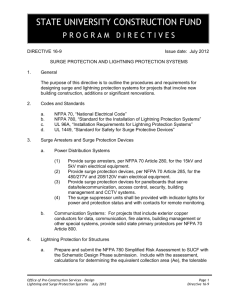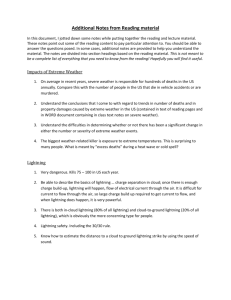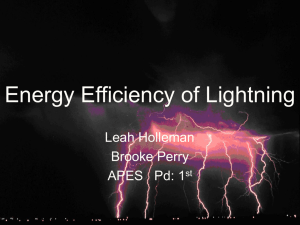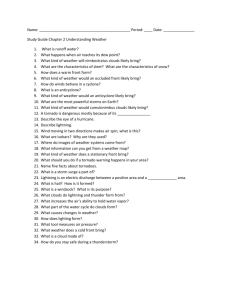9.17 Surge protection for transmitting/receiving systems
advertisement
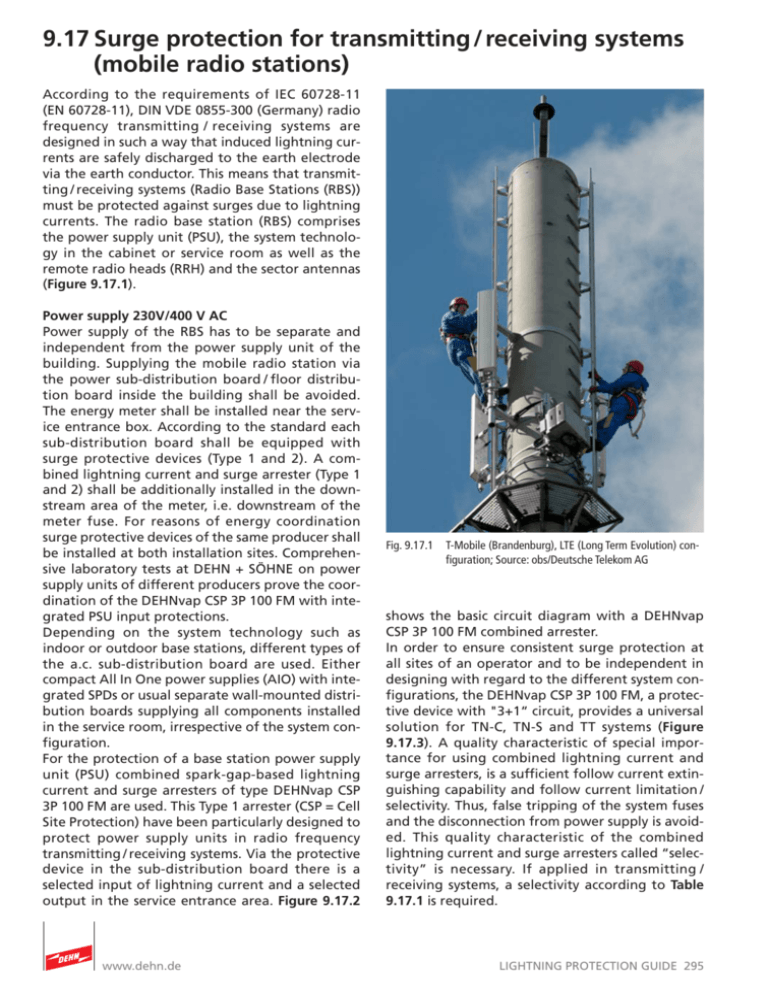
9.17 Surge protection for transmitting / receiving systems (mobile radio stations) According to the requirements of IEC 60728-11 (EN 60728-11), DIN VDE 0855-300 (Germany) radio frequency transmitting / receiving systems are designed in such a way that induced lightning currents are safely discharged to the earth electrode via the earth conductor. This means that transmitting / receiving systems (Radio Base Stations (RBS)) must be protected against surges due to lightning currents. The radio base station (RBS) comprises the power supply unit (PSU), the system technology in the cabinet or service room as well as the remote radio heads (RRH) and the sector antennas (Figure 9.17.1). Power supply 230V/400 V AC Power supply of the RBS has to be separate and independent from the power supply unit of the building. Supplying the mobile radio station via the power sub-distribution board / floor distribution board inside the building shall be avoided. The energy meter shall be installed near the service entrance box. According to the standard each sub-distribution board shall be equipped with surge protective devices (Type 1 and 2). A combined lightning current and surge arrester (Type 1 and 2) shall be additionally installed in the downstream area of the meter, i.e. downstream of the meter fuse. For reasons of energy coordination surge protective devices of the same producer shall be installed at both installation sites. Comprehensive laboratory tests at DEHN + SÖHNE on power supply units of different producers prove the coordination of the DEHNvap CSP 3P 100 FM with integrated PSU input protections. Depending on the system technology such as indoor or outdoor base stations, different types of the a.c. sub-distribution board are used. Either compact All In One power supplies (AIO) with integrated SPDs or usual separate wall-mounted distribution boards supplying all components installed in the service room, irrespective of the system configuration. For the protection of a base station power supply unit (PSU) combined spark-gap-based lightning current and surge arresters of type DEHNvap CSP 3P 100 FM are used. This Type 1 arrester (CSP = Cell Site Protection) have been particularly designed to protect power supply units in radio frequency transmitting / receiving systems. Via the protective device in the sub-distribution board there is a selected input of lightning current and a selected output in the service entrance area. Figure 9.17.2 www.dehn.de Fig. 9.17.1 T-Mobile (Brandenburg), LTE (Long Term Evolution) configuration; Source: obs/Deutsche Telekom AG shows the basic circuit diagram with a DEHNvap CSP 3P 100 FM combined arrester. In order to ensure consistent surge protection at all sites of an operator and to be independent in designing with regard to the different system configurations, the DEHNvap CSP 3P 100 FM, a protective device with "3+1“ circuit, provides a universal solution for TN-C, TN-S and TT systems (Figure 9.17.3). A quality characteristic of special importance for using combined lightning current and surge arresters, is a sufficient follow current extinguishing capability and follow current limitation / selectivity. Thus, false tripping of the system fuses and the disconnection from power supply is avoided. This quality characteristic of the combined lightning current and surge arresters called “selectivity” is necessary. If applied in transmitting / receiving systems, a selectivity according to Table 9.17.1 is required. LIGHTNING PROTECTION GUIDE 295 Remote Radio Head (RRH), 48V DC, for LTE (Long Term Evolution, 4G) With Remote Radio Head the 3rd generation of mobile radio technology (3G, UMTS) has been developed. The actual system technology is still located in the operation room or in the cabinet. Only the RRHs with the HF module are installed in close vicinity of the antennas. For communication between the HF heads and system technology, the coaxial cables have been replaced by glass fibre cables. For the operation of the RRHs (active system technology), however, a separate 48 V d.c. voltage supply from the service room is needed, realised by a cable of type NYCWY 2x16/16 mm². The shielded cable has to be earthed as required in the standard IEC 60728-11 (EN 60728-11), DIN VDE 0855-300 (Germany). If there is a building lightning protection system it has to be integrated in accordance with IEC 62305-3 (EN 62305-3). Already installed feeder cables may be also used for the d.c. supply of the RRHs as well as for communication between RRHs and system technology by means of special coaxial copper converters. As shown for the system power supply (main and sub-distribution board), there is a selected input of lightning current also in the d.c. box (mast) and a selected output in the OVP box (overvoltage protection box, service room). In both d.c. boxes (indoor and outdoor) d.c. Type 1 arresters with a low protection level are used which especially have been developed for use at RRH. In the d.c. box at the mast a "1+1“ circuit is implemented, the positive pole (0V) and the cable shield being indirectly connected via a so-called "total spark gap" due to the corrosion currents. Figure 9.17.4 shows the basic circuit diagram of Remote Radio Heads in case of spatially separated functional equipotential bonding levels. The surge protective devices used are shown in Table 9.17.1. antenna RRH (remote radio head) d.c. Box (outdoor box) socket outlet RBS (radio base station) airconditioning lighting power distribution cabinet upper floor EBB basement area kWh power distribution cabinet MEB existing earth electrode Fig. 9.17.2 Fixed network connection Either fixed network links via copper cable or radio links are chosen to connect the base stations with 296 LIGHTNING PROTECTION GUIDE EBB roof area Electrical circuit diagram the primary switching technology. In case of a fixed network connection, partial lightning currents will also flow through the telecommunica- www.dehn.de Fig. 9.17.2 Protection for... Type Part No. DEHNvap CSP 3P 100 FM 900 360 DEHNguard Modular DG M TT 275 FM 952 315 Remote Radio Head OVP box (indoor) DEHNsecure Modular DSE M 160 FM 971 126 Remote Radio Head d.c. box (outdoor) DEHNsecure Modular DSE M 2P 60 FM 971 226 LSA-Plus, series 2 DEHNrapid DRL 10 B 180 FSD 907 401 Screw terminal (recommendation DEHN + SÖHNE) BLITZDUCTOR XT BXT BD 180 + base part BXT BAS 920 347 920 300 GSM, UMTS, LTE / 876 ... 960 + GSM, UMTS, LTE / 2000 ... 6000 DEHNgate DGA L4 7 16 B or DEHNgate DGA L4 N EB 929 048 929 059 RiFu/2400 DEHNgate DGA G N 929 044 WLAN/2400 DEHNgate DGA G BNC 929 042 TETRA/380 ... 512 DEHNgate DGA L4 7 16 S 929 047 l. v. supply Combined arrester (Type 1 and Type 2) for power supply units l. v. supply of RBS Surge protection d.c. protection, 48 V supply of RRH Fixed network Transmission technology Table 9.17.1 Surge protection for mobile radio stations tion cable if a direct lightning strike hits the antenna system. In this case, combined SPDs also provide sufficient protection. Surge protective devices according to Table 9.17.1 are used. Radio transmission technology The radio transmission band and the connection mechanics are the decisive factors concerning the selection of suitable surge protective equipment for the protection of the radio transmission technology. Sufficient discharge capability, remote supply voltages of PTP radio systems, and depending on the application, also low passive intermodulation (PIM) have to be taken into account. Table 9.17.1 shows the DEHN + SÖHNE products for protection. www.dehn.de Lightning protection, earthing, equipotential bonding With regard to earthing, equipotential bonding, lightning and surge protection mainly IEC 6072811 (EN 60728-11), DIN VDE 0855-300 (Germany) as well as IEC 62305-3 (EN 62305-3) are applicable for design and installation of transmitting / receiving systems. A distinction has to be made whether a transmitting / receiving system must be installed on a building or structure with lightning protection system according to IEC 62305-3 (EN 62305-3) or without lightning protection system. Then, corresponding earthing and equipotential bonding measures have to be taken according to IEC 6072811 (EN 60728-11), DIN VDE 0855-300 (Germany) or IEC 62305-3 (EN 62305-3). Chapter 5.2.4.2 of the Lightning Protection Guide describes possible lightning protection measures for mobile radio stations. LIGHTNING PROTECTION GUIDE 297 Fig. 9.17.3 Basic structure of a RBS with DEHNvap CSP 3P 100 FM Fig. 9.17.4 Basic diagram of Remote Radio Heads (RRHs) in case of spatially separated functional equipotential bonding levels with d.c. box (mast) and DEHNsecure DSE M 2P 60 FM as well as OVP box (service room) with DEHNsecure DSE M 1 60 FM 298 LIGHTNING PROTECTION GUIDE www.dehn.de





